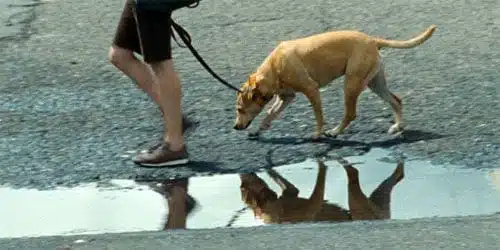
Wendy and Lucy is a modern American masterpiece. It is easily the most poignant films produced in this country last year and strikingly resonant in this year’s economic climate, as well as among the most memorable movies of the first decade of the new millennium. In the hands of the movie’s director, the brilliant Kelly Richardt, her co-screenwriter Jon Raymond, and the lead actor Michelle Williams, a portrait of a woman and her canine companion is transformed into a moving portrayal of contemporary American poverty, a story that is both personal and political.
Wendy and Lucy is not an easy film, but its themes and challenges make it all the more vital. The film begins abruptly as Wendy (Williams) and her partner Lucy (Reichardt’s own dog) are stranded in a sinking industrial town in Oregon when her beat-up Honda fails halfway to their destination in Alaska. It is immediately clear that Wendy is less an itinerant wanderer and more a woman undergoing a complex internal struggle resulting in an intense determination to go north, where she hopes to find work in a cannery.
Suddenly Wendy, who was barely keeping her head above water financially and emotionally, finds herself sinking into destitution. Each new setback forces her to make tough economic decisions. When she loses her dog she must gird her will and muster hope as she spends the rest of the film searching fervently for her lost companion.
Wendy and Lucy is based on Raymond’s own short story “Train Choir” — itself a minor masterpiece — though Reichardt’s film could just as easily be a screen adaptation of Barbara Ehrenreich’s Nickel and Dimed, an exposé on working poor in America, or a remake of the Vittorio De Sica’s neo-realist film, Umberto D. That said, familiarity with either of those works is unnecessary to appreciate Wendy and Lucy, a film so profoundly immediate, so full of vitality, that seems less like a work of fiction and more like the dilemma of a close friend.
Here the credit belongs equally to Reichardt and Williams. The former, one of our nation’s finest working directors, last offered us Old Joy (another collaboration with Raymond), an intimate portrait of friendship and alienation under the dark years of George W. Bushes’ presidency, and continues with this latest film to be a relevant and reverent filmmaker — deeply respectful of story, character and audience.
Reichardt is equally respectful of other filmmakers; rather than overload the DVD release with the now-de-rigueur and often extraneous “extras” or self-aggrandizing director’s commentary, Reichardt instead has chosen to showcase works made by four of her Bard College colleagues: Peter Hutton, Peggy Ahwest, Les LeVeque and Jacqueline Goss. Ranging from the playful and poignant How to Fix the World, Gross’ exploration of a neuropsychologist in Uzbekistan, to Ahwesh’s childlike renderings of horror genre The Scary Movie, the films place Wendy and Lucy in the context of avant-garde cinema rather than the neorealist tradition to which many reviewers have ascribed Reichardt’s work.
Williams, who has taken increasingly more challenging roles over the past four years, is absolutely stunning in her rendition of the analytical, guarded Wendy. Her portrayal of Wendy evokes a character who is brave, defiant, vulnerable and nonexempt to all of the twists of fate that feel both tragic and mundane.
In Williams’ hands, and in Reichardt’s, it’s impossible to romanticize Wendy or see her solely as a victim. The predicament she finds herself in is at least in part due to her own decisions, though her agency is debatable, given the situation society has placed her in. Further, like another character setting out for Alaska, Chris McCandless in Into the Wild, Wendy is a character surrounded by kindness and humanity though she sees only herself.
Each character who comes into contact with Wendy attempts, in small ways, to offer their help. These include cogitative performances by Wally Dalton, a weary but thoughtful security guard, Will Patton, a matter-of-fact mechanic, and Ayanna Berkshire, a sympathetic employee at the city pound. Dalton’s security guard befriends Wendy after kicking her out of the “private” Walgreens parking lot, sharing his cell phone, his familiarity with the city’s streets, and his hope. Only when he offers her money (the sum is menial) is Wendy reminded of their separate lives. This interaction injects a disquiet and familiar mistrust into a friendship that had briefly transcended class.
You may either admire or despise Wendy depending on your politics, but it is impossible not to identify with her. Lucy is off-camera for the majority of the film, but her influence over Wendy’s actions and her ceaseless presence in Wendy’s thoughts, provides the perfect point of entry into a state of mind that is universally familiar. Wendy is deeply American, as is her predicament. Thanks to deliberate casting and costume design, and thoughtful acting, she cannot be dismissed as the “Other” in a country where poverty is as delicate a subject as race, and all too often the two are lumped together by people in comfortable economic positions.
It is for this reason, among so many others (crisp cinematography, naturalism in acting, Will Oldham’s gorgeous melody that is perpetually hummed by Williams), that Wendy and Lucy is a great triumph. It is rare that a film captures a story so true and simultaneously so deeply affecting.
In America, where citizens can simultaneously vote to expand the rights of animals while denying rights to fellow human beings, a film like Wendy and Lucy forces us to empathize and identify with a woman and her animal partner, brilliantly managing to humanize both.

